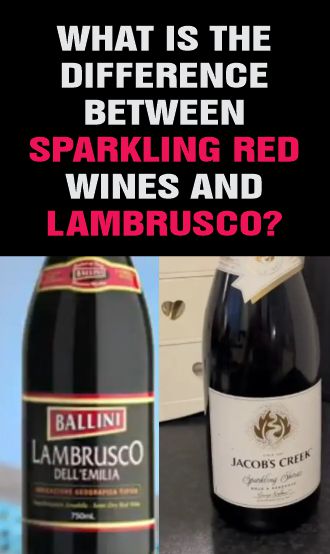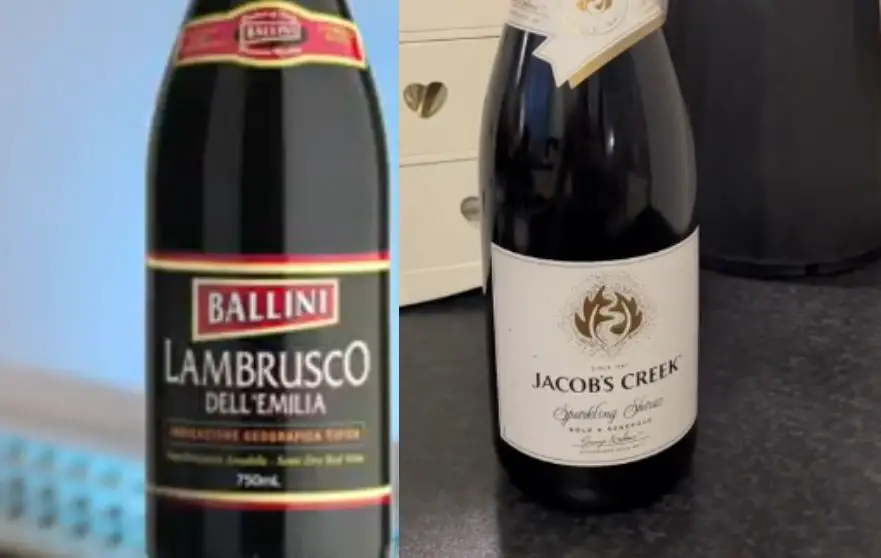Last updated on October 26th, 2025 at 06:42 pm
What is the difference between sparkling red and Lambrusco? Explore their unique production methods, flavor profiles, and best food pairings in this comprehensive guide.
Sparkling red wines and Lambrusco, both beloved for their effervescent charm, offer distinct experiences for wine enthusiasts.
While sparkling reds encompass a broad category of bubbly wines made from various red grapes, Lambrusco is a specific type hailing from Italy’s Emilia-Romagna region.
Understanding the differences in their production methods, flavor profiles, and ideal food pairings can enhance your appreciation of these unique and flavorful wines.
Recommended: The Red Wines: Types and Characteristics
You might want to pin the image below.

Table of Contents
- An Overview of Sparkling Red and Lambrusco Wines
- So, What is the Difference Between Sparkling Red and Lambrusco?
- Differences in Flavor Profiles and Tasting Notes of Sparkling Red and Lambrusco
- The Difference in Food Pairings and Serving Suggestions for Sparkling Red and Lambrusco Wines
- Final Words from Gentsways
An Overview of Sparkling Red and Lambrusco Wines
Sparkling red wines occupy a unique niche in the sparkling wine category, known for their vibrant effervescence and diverse flavors.
Made from various red grape varieties, these wines are carbonated to produce their signature bubbles, with each type offering distinct taste profiles influenced by grape variety and production methods.
Lambrusco is a prominent type of sparkling red wine from the Emilia-Romagna region in Italy, celebrated for its lively bubbles and a range of sweetness levels, from dry to sweet.
With a history dating back to Roman times, Lambrusco holds a significant place in Italian winemaking and is commonly associated with celebrations and gourmet pairings.
Globally, both sparkling red wines and Lambrusco are highly popular, and revered for their deep hues, lively bubbles, and ability to capture the essence of their respective terroirs.
As interest in regional and artisanal wines grows, so does the profile of these sparkling reds.
Related: Everything to Know about the Rosé Wines
So, What is the Difference Between Sparkling Red and Lambrusco?
Differences in the Production Methods of Sparkling Red and Lambrusco Wines
The production methods for sparkling red wines and Lambrusco influence their flavor profiles, textures, and overall character.
Sparkling Red Wines
Traditional Method (Méthode Champenoise): Involves a second fermentation in the bottle, creating complex flavors and a smooth texture due to extended contact with lees.
This method typically involves aging, allowing the wine to develop nuanced aromas and a fine mousse.
Charmat Method: Second fermentation occurs in large, pressurized tanks, resulting in fruitier, fresher wines with vibrant effervescence.
The reduced contact with lees leads to cleaner, straightforward flavors.
Carbonation: A simpler method where carbon dioxide is injected into the base wine, producing bright, simple flavors with less complexity compared to other methods.
Lambrusco
Ancestral Method: One of the oldest techniques, this method involves bottling the wine before fermentation is complete, resulting in a naturally sparkling wine with a rustic character and slightly yeasty flavor.
Charmat Method: Used in contemporary Lambrusco production, this method creates fresher, more accessible wines that maintain fruity and floral notes with lively, persistent sparkle.
Related: Gentleman’s Introduction to Wine Pairing
Differences in Flavor Profiles and Tasting Notes of Sparkling Red and Lambrusco
Sparkling red wines offer a broad spectrum of flavor profiles, often featuring dark fruits like blackberries, plums, and cherries, with underlying hints of chocolate, spices, and sometimes smokey undertones.
These wines balance sweetness and acidity, appealing to a wide range of palates.
Lambrusco Variants
Lambrusco di Sorbara: Light and floral, with delicate notes of red berries, cherries, and a hint of rose. It typically has a drier finish with a crisp, clean mouthfeel.
Lambrusco Grasparossa: Known for its deeper color and robust flavor profile, featuring dark cherries and violets, often with a slightly tannic structure and a medium to dry finish.
Lambrusco Salamino: Sweeter, with ripe berry flavors and subtle floral undertones, offering a smooth, semi-sweet finish.
Lambrusco Reggiano: Balanced sweetness and acidity, highlighting strawberries and raspberries with a soft, bubbly feel on the palate.
Related: Wine Regions Around the World
The Difference in Food Pairings and Serving Suggestions for Sparkling Red and Lambrusco Wines
Sparkling red wines and Lambrusco are highly versatile when it comes to food pairings.
Sparkling Red Wines
Their effervescence and robust flavors pair well with hearty dishes like barbecue, roasted meats, and rich cheeses.
For instance, a sparkling Shiraz pairs beautifully with a rack of ribs or spicy sausages, as the fizz complements the smokiness of the dishes.
Lambrusco
This wine pairs exceptionally well with Italian cuisine, especially pasta dishes with rich tomato sauces.
Amabile and Dolce variants of Lambrusco enhance the flavors of lasagna and spaghetti carbonara, while Secco versions pair well with lighter fare like antipasti and seafood.
Lambrusco also complements cured meats and a variety of cheeses.
For optimal enjoyment, both sparkling red wines and Lambrusco should be served slightly chilled (10-12°C or 50-54°F) in tulip-shaped glasses to concentrate the aromas. Swirling the wine before sipping can enhance its aromatic qualities.
These wines are perfect for both intimate dinners and festive celebrations, with Lambrusco being particularly suited for casual gatherings where Italian dishes are celebrated.
Final Words from Gentsways
What is the difference between sparkling red and Lambrusco? Sparkling red wines and Lambrusco each offer unique attributes that cater to diverse preferences.
Sparkling red wines, with their varied production methods, provide a wide range of flavors and textures, making them versatile for pairing with robust dishes.
In contrast, Lambrusco, with its deep Italian roots and specific styles, excels in complementing Italian cuisine and casual gatherings.
Exploring these differences enriches your wine experience and enhances your enjoyment of these effervescent delights.
References:
- https://minuman.com/blogs/all/discovering-lambrusco-the-sparkling-red-wine-from-italy
- https://shop.silvanoromaniparma.com/comparison-lambrusco-other-wines
- https://wineinsiders.com/blogs/wine-101-wine-basics/the-ultimate-guide-to-lambrusco-wine
Pyo Merez is a men’s lifestyle enthusiast and writer about the gentleman’s place and impact on society. Raised by a distinguished gentleman dad, he offers unique insights into how the mind of a gentleman works and how societal norms shape gentlemen’s identity and vice versa.
Through his insightful articles, Pyo taps into the depths of gentleman culture to provide perspectives on etiquette and manners in modern society.

